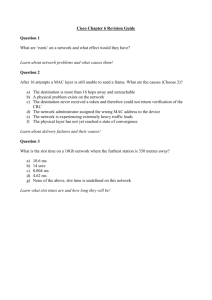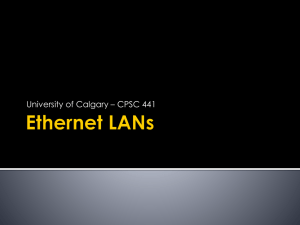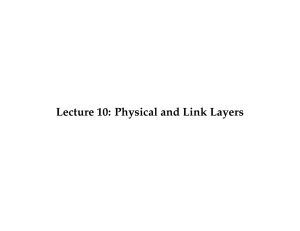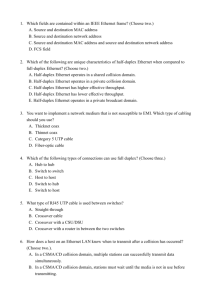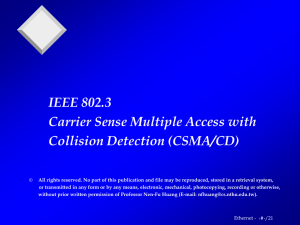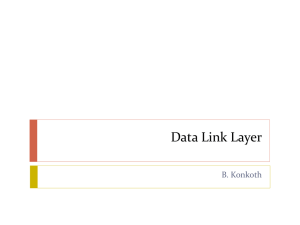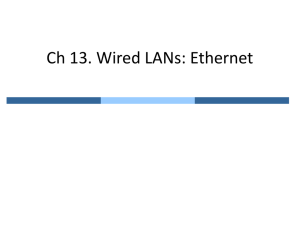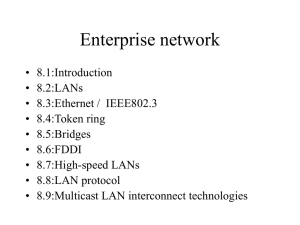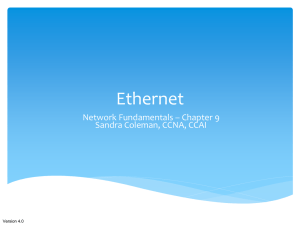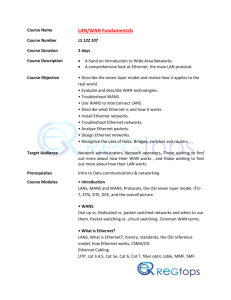PowerPoint
advertisement
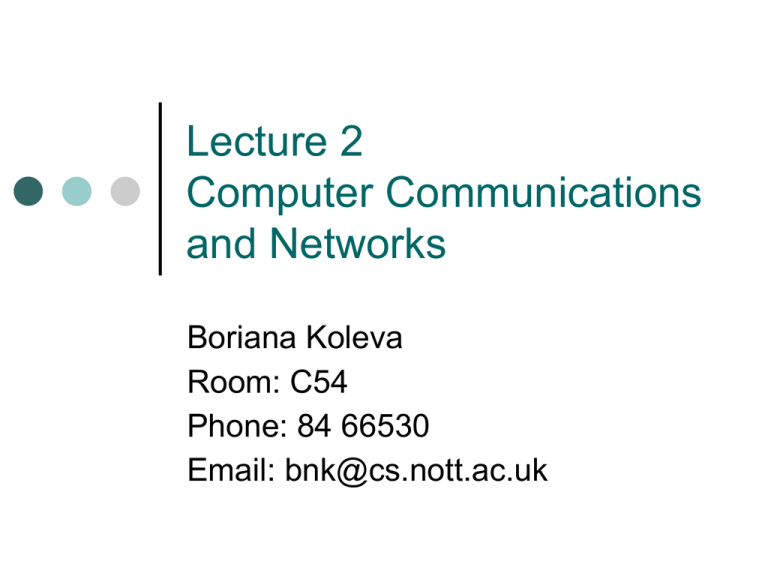
Lecture 2 Computer Communications and Networks Boriana Koleva Room: C54 Phone: 84 66530 Email: bnk@cs.nott.ac.uk Introduction Local communication • Encoding data • LANs Long Distance communication • Modulation • Modems and broadband connections Transmission Media Copper Wires • Twisted Pair • Coaxial Fibre Optic Radio Microwave Infrared Satellites Transmitting data over short distance Changes in electric current used to transmit bits over short distance • E.g. RS-232 (serial port) Voltage + Time 1 0 1 0 0 0 Shared Communication Channels Early local networks used dedicated links between each pair of computers • But poor scalability Shared LANs invented in the 1960s Rely on computers sharing a single medium Computers coordinate their access Low cost But not suitable for wide area - communication delays inhibit coordination Local Area Network (LAN) How are computers wired together in a LAN? – 3 common topologies Star hub Bus (shared cable) Ring Ethernet Ethernet is a bus LAN topology Invented at Xerox PARC in the early ’70s Developed commercially by 3COM later Standards controlled by IEEE Today it is the most widely used network topology for LANs Older Ethernet wiring schemes “Thick” Ethernet • The original Ethernet standard • Coaxial cable – computers connected via transceivers “Thin” Ethernet • Coaxial cable – computers directly connected via BNC Twisted Pair Ethernet Is twisted pair Ethernet a bus or star? • Logically it is a bus • Physically it is a star Sharing the Ether Data is divided into small chunks called “packets” which may be one of a number of standard types A packet sent from one computer propagates to either end of the cable The packet is ignored by every computer on the network except the destination computer Ethernet Co-ordination Ethernet systems do not have a central controller telling computers when they can talk All computers on an Ethernet network use Carrier Sense Multiple Access (CSMA) • The electrical activity that occurs during packet transmission is called the carrier • Before transmitting a packet a computer checks for a carrier and only transmits when the network is quiet • Checking for a carrier is called Carrier Sense • The whole process is CSMA Collision Detection CSMA prevents computers from interrupting ongoing transmissions CSMA does not prevent simultaneous transmissions Simultaneous signals will interfere – this is called a collision, which will damage data in both packets Ethernet has collision detection (CD) • The sending computer monitors the signal on the ether • If this signal differs from what was sent a collision must have occurred The whole system is CSMA/CD Collision Handling When CSMA/CD detects a collision, both computers must re-send their data This does not happed immediately (to avoid another collision) Both computers wait a random amount of time (the maximum allowed is a part of the Ethernet standard) The data is sent again, once the network is quite If there is a second, collision the maximum delay is doubled, etc. Exponential backoff Sending bits over long distance Encoding data as discrete voltage changes doesn’t work over long distance as the signal attenuates A continually oscillating wave travels further Bits of data are modulated onto a carrier wave Modulation and demodulation is done by a modem Amplitude Modulation Frequency Modulation Phase shift modulation Modems Hardware that takes bits and applies modulation is a modulator Hardware that takes a modulated wave and extracts bits is a demodulator Full duplex communication requires a combined modulator-demodulator (MODEM) at both ends Example modem connection Dial-up modem configuration Terminology Bandwidth – the number of signals per second that a medium can accommodate Multiplexing - several logical connections share a single physical connection Broadband - a transmission method which supports a relatively wide range of frequencies which may be divided into channels Digital Subscriber Line (DSL) Telephone exchange Uses the two-wire local loop from the local telephone exchange to homes Normal telephone lines are limited to the frequency range of human voices (03400 Hz) DSL uses the entire bandwidth of the local loop However, capacity decreases with connection distance • limit 18,000 feet (5,460 m) Digital Subscriber Line (DSL) DMT (Discrete MultiTone) divides the data into 247 separate channels, each 4 KHz wide • equivalent of 247 modems connected to your computer at once! • Channel 0 is used for voice • Usually 80-90% of the rest of the channels are used for downstream communication (Asymmetrical DSL) Digital Subscriber Line (DSL) ADSL speed – max. downstream 8 Mbps and max. upstream 1 Mbps • up to distance of 2 km As of 2009 the latest standard ADSL2+ can deliver up to 24 Mbps Summary Local communication • Encoding data • LANs • Topologies • Ethernet (wiring schemes and coordination) Long Distance communication • Modulation • Modems and broadband connections
